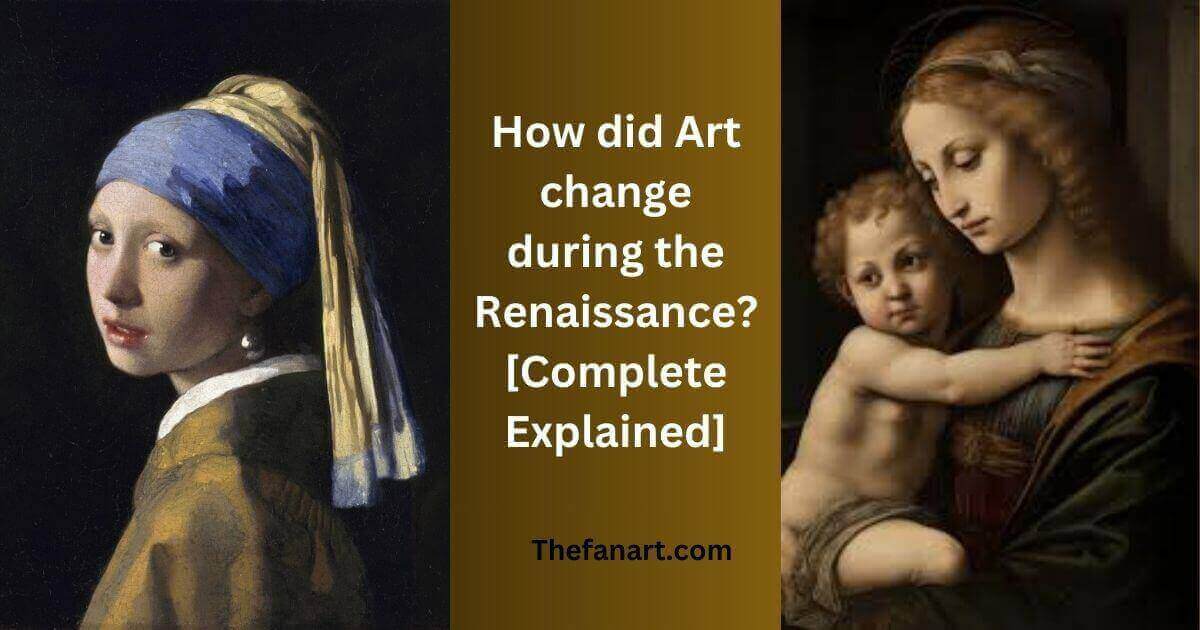Renaissance means “Rebirth”, which is a French word. It is a period in European civilization post-Middle Ages characterized by Classical scholarship renewal and values. So, How did Art change during the Renaissance? Before the Renaissance, art mostly reflected religious themes, but Italian artists began to go for humanism and realism in the 1300s. It brings a shift towards presenting people in their natural states, which is modern art.
The Renaissance sparked a renaissance of humanism, nature, and interactions. It focuses on human behavior and emotions. The Renaissance is the period from the 14th to 17th centuries. It represents secular themes, realism, and naturalism. Renaissance art values perspective, realism, and a focus on secular subjects like portraits and still life paintings. Art forms during this period included sculptures, decorative arts, oil paintings, and music.
Impact of Renaissance Art
Renaissance art change continues to influence modern teaching, history, and art styles. Techniques like oil paintings and sculptures have grown with many contemporary artists who have drawn inspiration from Renaissance masters. Renaissance brings new ways to find the place of humanity in this world through Naturalism, Contrapposto or Linear Perspective. Renaissance Humanism emerged, focusing on classical texts and human potential. Shift towards reason and scientific inquiry, challenging religious dogma. The printing press revolutionized the worldview of knowledge and ideas.
There was a major rise in the middle class, which brought a shift from feudalism to a capitalist market economy. The decline of feudal allegiances raises secularization. The major exploration of the Renaissance led to European colonization, exploitation, and the trans-Atlantic slave trade.
There is a rediscovery of ancient scientific knowledge in that period. It is an observation and experiment. Nicolaus Copernicus proposed a heliocentric model of the universe, where Earth and planets revolve around the sun. Copernicus’ model resolved the mathematical problems of the geocentric model and became the foundations for modern astronomy. Galileo’s persecution is a conflict between scientific progress and religious authority.
Festivals during the Renaissance celebrated art, culture, and significant events, reflecting the vibrancy of Renaissance society. The Renaissance laid the foundation for the modern world, influencing science, art, philosophy, and trade.
You can attend different Renaissance festivals around the world. Renaissance festivals share the vibrant culture of the 16th century. Phyllis Patterson initiated the first Renaissance Pleasure Faire in Los Angeles in May 1963. The fair evolved from a one-weekend event to a larger, multi-weekend affair. Renaissance Entertainment Corporation acquired the California fairs in 1994, marking a shift towards commercial entertainment. The appeal of Renaissance fairs lies in their contrast to mainstream theme parks, offering a mix of danger, history, and eroticism.
Historical Figures of the Renaissance Period
Many Renaissance figures have had a significant impact on today’s world. We are still knowledgeable about most of the work of the Renaissance artists.
Leonardo da Vinci is an Italian polymath known for his contributions to art, science, and engineering. Leonardo has masterpieces such as the Mona Lisa and The Last Supper. He has noticeable scientific inventions.
Michelangelo Buonarroti is an Italian sculptor, painter, architect, and poet. Michelangelo is best known for his sculptures, including the David and the Pieta, and his work on the ceiling of the Sistine Chapel in Rome.
Niccolò Machiavelli is an Italian diplomat, philosopher, and writer. Machiavelli’s most famous work, “The Prince,” explores the nature of power and politics. It is offering pragmatic advice on governance.
Desiderius Erasmus is a Dutch philosopher, theologian, and humanist. Erasmus was a leading figure of the Northern Renaissance. He works to improve religious tolerance, education, and reform within the Catholic Church. Read about What are some of the Purposes of Christian Art now.
William Shakespeare is an English playwright, poet, and actor. Shakespeare’s works, including plays such as “Hamlet,” “Romeo and Juliet,” and “Macbeth,”. It represents the exploration of human nature.



